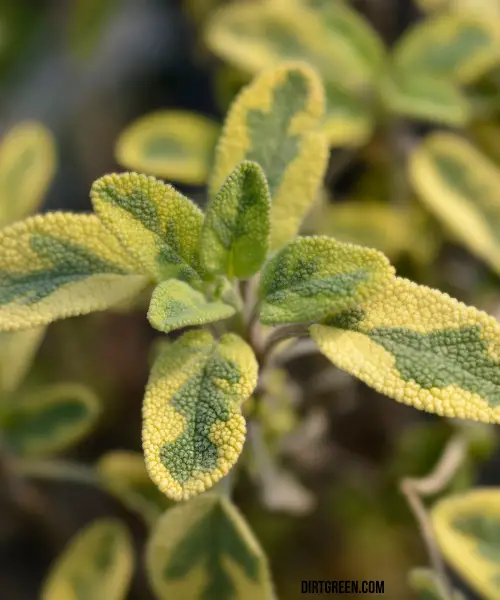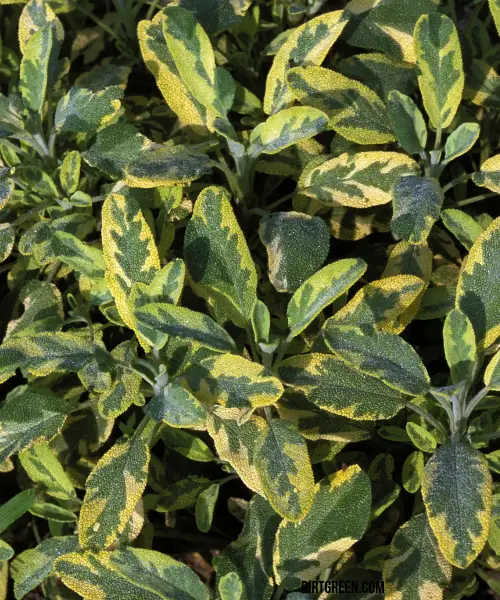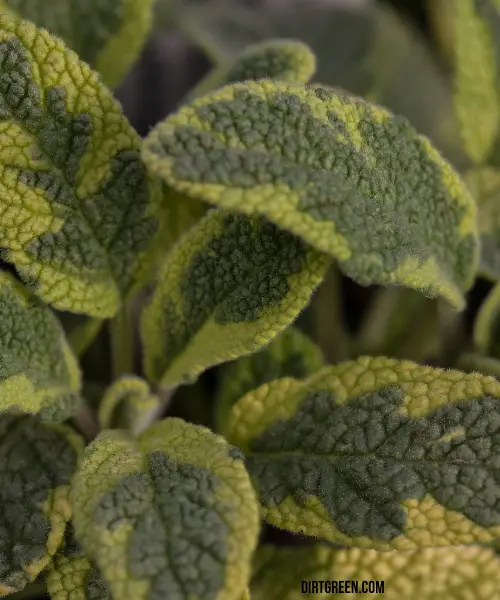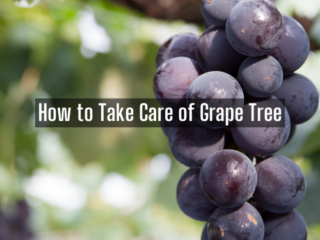In the garden, Salvia aurea, sometimes known as the golden sage, is quite stunning. Bold color and texture are added by its velvety gray-green leaves and tall spikes of golden-yellow blooms, which are difficult to overlook.
This perennial sage variety is native to the southwestern United States and northern Mexico, thriving in hot, dry climates. While relatively low-maintenance once established, there are some key tips to keep in mind when growing golden sage to ensure it looks its best year after year.
Getting Started With Golden Sage

Golden Sage Plant
Golden sage is a subshrub that forms a low-growing mound or small shrub, reaching about 2–3 feet tall and wide at maturity. It is winter-hardy in USDA zones 7–10, where it can remain evergreen through mild winters. In colder zones, it can be treated as an annual or the roots may need winter protection.
Golden sage can be planted in early spring once the threat of frost has passed. It prefers very well-drained soil in a sunny location receiving 6–8 hours of direct sun per day. Too much shade will result in floppy, stretching growth. Amend the planting area with compost or other organic matter to improve drainage and nutrients if needed.
Space plants about 2–3 feet apart in the garden bed. Golden sage has a sprawling, trailing habit so allow plenty of room for it to fill out. Using a low barrier, like decorative edging, can help define the planting area and contain the plant’s spread.
This sage is very drought-tolerant once established, but consistent watering is important when first transplanted to help the developing root system. Water regularly for the first few months whenever the top inch of soil becomes dry.
Mid-Spring through Fall Care
Golden sage is exceptionally heat- and drought-tolerant, thanks to its native habitat. However, it will perform best with some supplemental watering during hot, dry periods. About 1 inch of water every 1-2 weeks is sufficient, applying directly to the soil at the base of the plant. Established plants can tolerate periods of drought by dropping some foliage and then bouncing back with new growth after quenching rains.

In early spring, prune off any dead or damaged stems from winter by cutting back to the basal foliage. A light overall pruning at this time can also help promote bushier growth. Remove any weak, spindly growth and prune off the tips of long trailing stems if desired for a more compact shape. However, avoid shearing the plant into tight geometric shapes, as this can look unnatural.
To encourage a flush of yellow flower spikes blooming in summer, feed plants in early spring with a balanced or bloom-boosting fertilizer. The tall flower stems add great vertical interest to borders and also attract bees, butterflies, and hummingbirds. Leave spent flowers on the plant after blooming to self-sow seed.
In cold winter climates, cut plants back to the ground after blooming and wait for new growth to emerge in spring. In mild winter areas, foliage may remain evergreen with some pruning to neaten the plant’s appearance.
Golden sage makes an excellent addition to hot, sunny gardens like those found in deserts and beach areas. The aromatic foliage is beautifully textured and deer-resistant, plus it is extremely xeriscape-appropriate. Use in borders, rock gardens, containers, or as low informal hedges.
Potential Issues with Golden Sage
Golden Sage is quite low-maintenance, but watch for a few potential issues. Root rot from overly wet or poorly draining soil is one threat. Dormant plants allowed to stay dry for too long can die out over the winter months.
Spider mites can be a problem, appearing as tiny webs between stems and leaves. Use a blast of water to dislodge the mites or insecticidal soap if the infestation is severe.
Leaf scorch and discoloration, such as purple or yellow foliage, can signal over or underwatering. Adjust moisture levels as needed.
In gardens where root competition is fierce, golden sage may become rather woody and open in the center over time. Periodic rejuvenation by pruning can help restore a fuller, bushier shape.
Sage varieties are known to be susceptible to Verticillium wilt, though this fungal disease is not overly common with golden sage. Avoid planting in areas where the disease is present in the soil, which causes wilting and death of stems and leaves. There is no cure, so affected plants must be promptly removed and the area replanted with resistant species.
Golden sage is generally a low-pest plant thanks to its strong scent and furry leaves. But it can attract spider mites in hot, dusty weather as well as whiteflies if stressed. Keep plants healthy through proper watering and fertilizing to minimize pest issues.
Golden sage is deer- and rabbit-resistant in most regions, though hungry animals may nibble on it during lean times. Keep this in mind in rural areas or place a barrier around vulnerable plants if needed.

Though native to hot, arid zones, it can be grown successfully in most regions with the right care.
- Plant in full sun and very well-drained soil
- Allow room for its sprawling growth habit, which is around 2–3 feet wide
- Water consistently when newly planted to establish roots
- Drought-tolerant once established, water deeply every 1-2 weeks in hot, dry conditions
- Prune yearly in early spring and remove spent flower stalks as desired
- Feed in spring to boost blooms, then let the seed drop to self-sow
- Watch for spider mites, whiteflies, root rot, or Verticillium wilt and treat promptly
- Cut back before winter in cold areas or leave semi-evergreen in mild zones
- Deer- and rabbit-resistant traits make it ideal for native gardens
Propagating Golden Sage
In addition to self-sowing, golden sage can be propagated from seed, cuttings or division to produce new plants. All methods work well for this vigorous grower.
From Seed
Start golden sage seeds indoors about 8–10 weeks before your last expected spring frost date. Use a seed starter mix and lightly cover the tiny seeds, as they need some light to germinate. Keep the soil moist and provide plenty of bright light. Seeds should sprout within 14–21 days.
Gradually expose the seedlings to longer periods of direct sunlight and cooler temperatures before transplanting outdoors after the danger of frost has passed. Space seedlings 2-3 feet apart in well-drained soil.
From Cuttings
Golden sage can be propagated from stem tip cuttings in spring or early summer. Use sharp pruners or scissors to take 4-6-inch cuttings from healthy, non-flowering stems. Remove the lowest set of leaves and dip the cut ends in rooting hormone powder.
Plant the cuttings in a container filled with a sterile, well-draining potting mix. Firmly pack the soil around the base of each cutting. Keep the potting mix moist but not soggy. Roots should form in 4-6 weeks.
Once rooted, transplant the new golden sage plants into your garden bed, spacing them 2-3 feet apart.
By Division
Established golden sage plants can be divided every 3–4 years in early spring as new growth is beginning. This will help rejuvenate the plant’s appearance and provide new starts to expand your planting.
Carefully dig up the entire root system and use a sharp spade, knife, or pruner to section off healthy rooted clump divisions from the outer edges of the plant. Discard any woody, dead, or diseased portions from the center.
Replant the divisions immediately at the same depth as before, spacing holes 2-3 feet apart. Water the well and continue regular irrigation until it becomes re-established.
Using Golden Sage in the Garden
Thanks to its compact size and drought tolerance, golden sage is extremely versatile in garden design. Here are some top ways to use this sun-loving beauty:
Xeriscape and Desert Planting
Golden sage thrives in hot, arid conditions and requires very little supplemental water once established. This makes it perfect for including in a xeriscape, rock garden, or desert-themed planting area. Group it with other drought-busting companions like agave, yucca, and penstemon.
Mediterranean Garden
The gray-green foliage and dusty golden blooms give golden sage a Mediterranean flair. Use it as low edging or filler along sunny paths or in herb gardens designed with an Italian or Spanish aesthetic. Let it trail over walls or containers for an earthy look.
Cottage Garden Charm
Even though it loves heat, golden sage has a delicate, airy presence that blends nicely into an English-style cottage garden setting. The ferny texture contrasts beautifully with rose bushes, daisies, and other classic bloomers. Let it soften the edges of hardscaping, like steps or pathways.
Pollinator Gardens
The tall spikes of golden yellow blooms are extremely attractive to bees, butterflies, and hummingbirds. Golden sage makes an ideal planting for pollinator and wildlife gardens, providing nourishing nectar from early summer through fall when many other plants have faded.
Sensory Garden
In addition to flashy color, golden sage engages the senses of smell and touch. The woolly, gray-green leaves release an herbal, slightly pungent aroma. Let kids run their hands through the foliage to experience the velvety, soft texture.
Containers
For gardeners in colder climates, try growing golden sage in containers that can be moved inside during the winter. Use a well-draining potting mix and give the plant as much direct sun exposure as possible during the growing season before bringing it indoors before the first frost.
With its drought-toughness and gorgeous golden blooms, sage is a wonderful choice for gardens in hot, sunny areas. By mastering just a few important growing requirements, you’ll be rewarded with clouds of yellow flowers and fragrant foliage for months on end.




